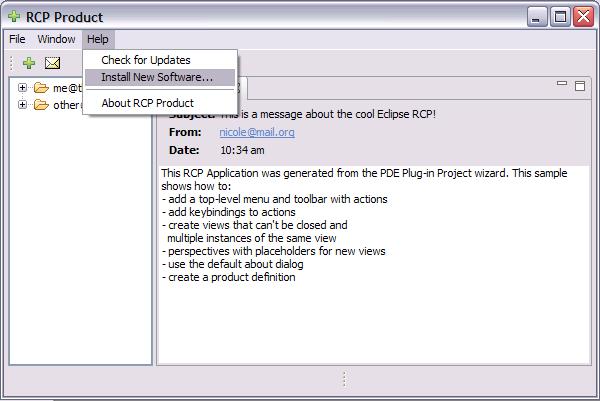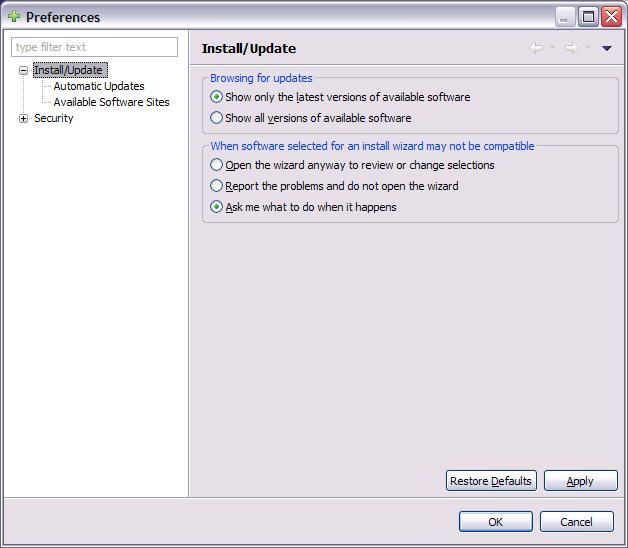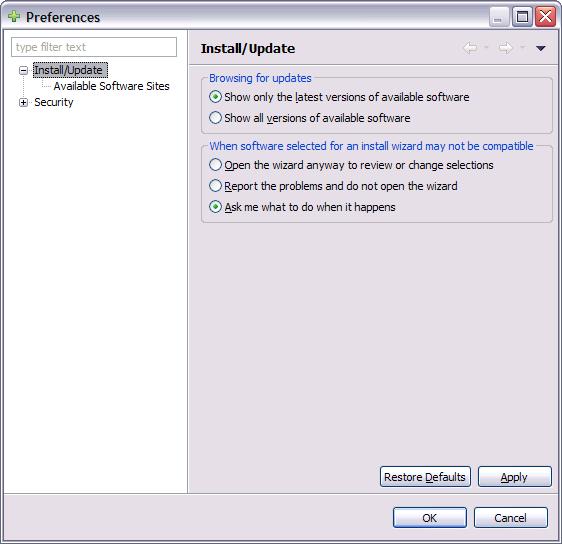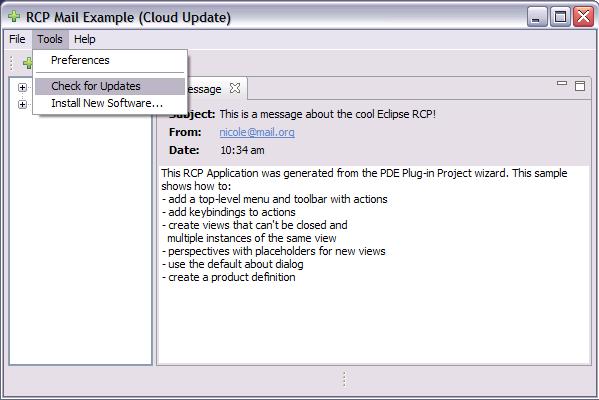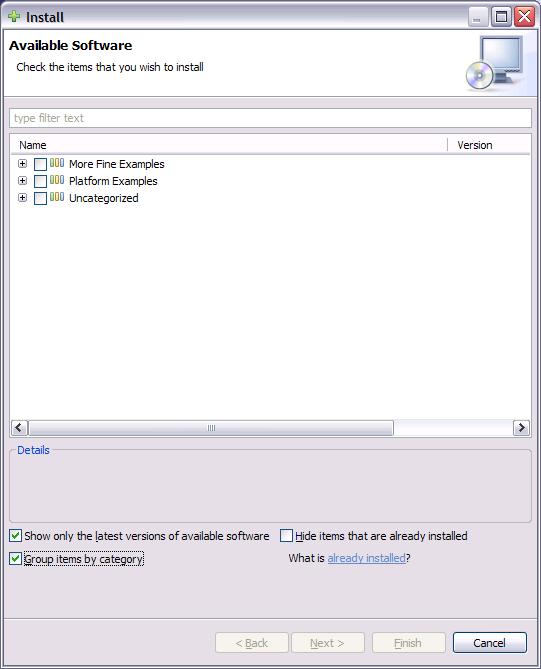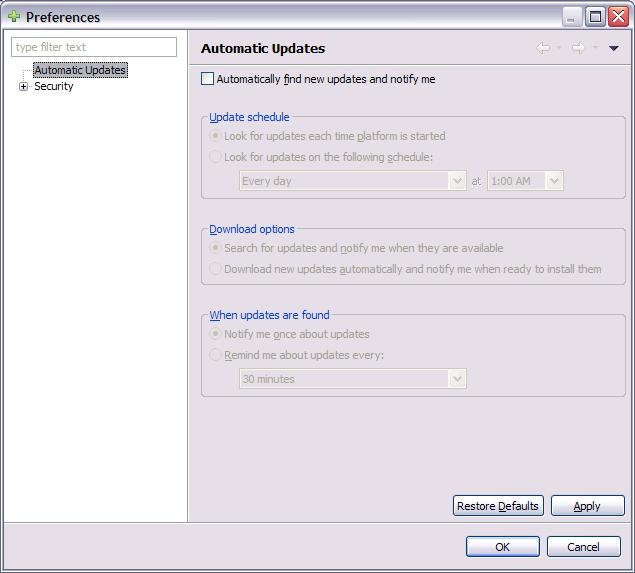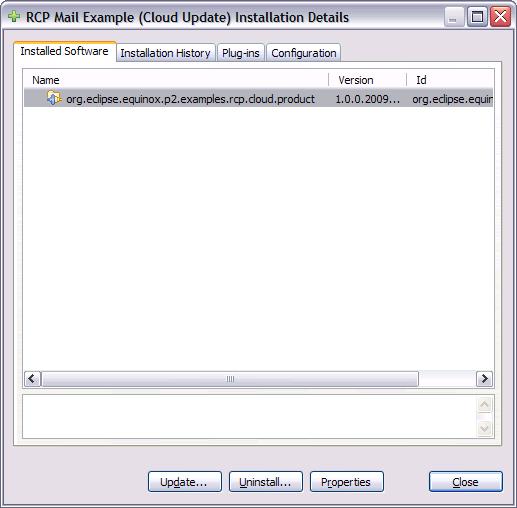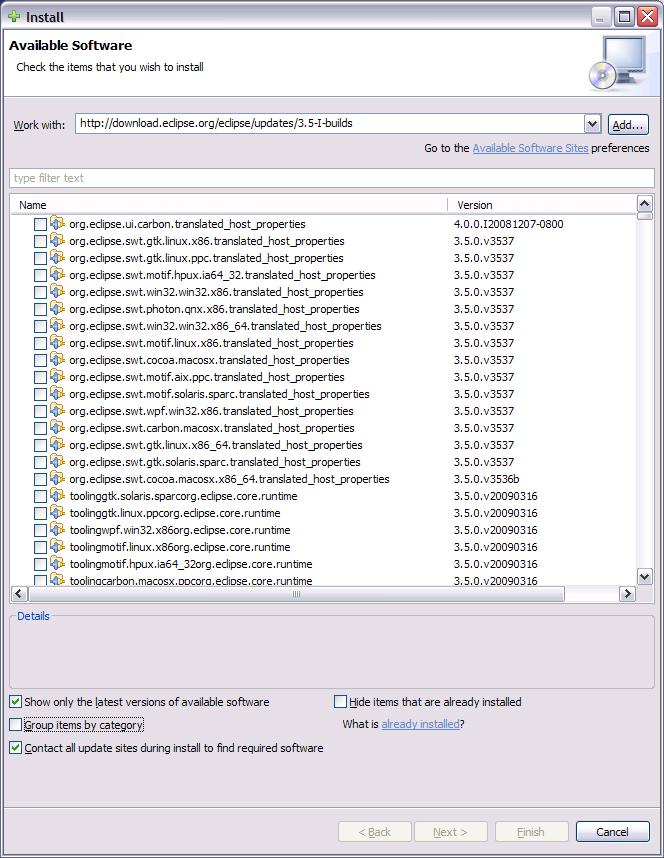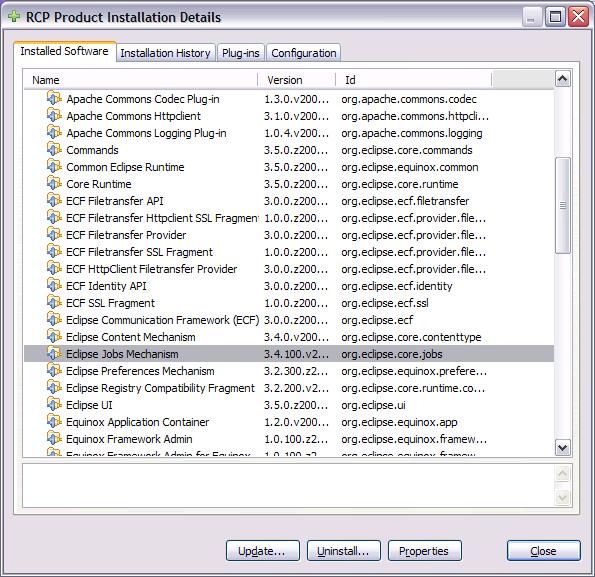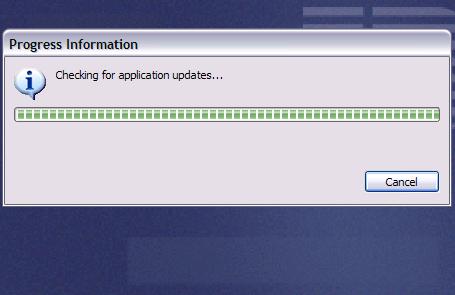Notice: This Wiki is now read only and edits are no longer possible. Please see: https://gitlab.eclipse.org/eclipsefdn/helpdesk/-/wikis/Wiki-shutdown-plan for the plan.
Equinox/p2/Adding Self Update to an RCP Application-3.5
This page consolidates information about how to add p2 self-updating support to your RCP application using the p2 provisional APIs in 3.5.
We start with the RCP Mail example application and modify it in different ways.
Contents
- 1 Adding p2, building, and provisioning your application with p2
- 2 Configuring the user's default repositories
- 3 Configuring the p2 UI
- 4 Headless Updating on Startup
- 5 Helpful Links
Adding p2, building, and provisioning your application with p2
The process for setting up your application to update with p2 involves several steps.
- The p2 bundles must be added to your application. This can be expressed by including the p2 bundles in one of your product's features (using the feature org.eclipse.equinox.p2.user.ui as a guide). It can also be done by expressing requirements in your features and letting the p2 install of your application pull in the right code.
- Set up a build for your product. This includes
- installing the delta pack for headless builds
- specifying the normal build steps in your build.properties
- adding some p2-specific steps to the build
- export the metadata for your build into a p2 repository
- run the p2 director to provision the application
This process is described in more detail in Andrew Niefer's blog post on the topic.
An example build based on a modified RCP Mail application can be found in P2 Git (legacy CVS was here).
Configuring the user's default repositories
The repositories that should initially be present in the application can be controlled using touchpoint instructions. The addRepository instruction should be used for each repository. In the p2 UI, we assume "colocated" metadata and artifact repositories. When the user adds a repository in the UI, both a metadata and an artifact repository are added for that location. When using touchpoint instructions, both the metadata and artifact repository must be added.
These instructions can be specified using a touchpoint advice file (p2.inf) that is included with the application. See Equinox/p2/Engine/Touchpoint_Instructions for more details.
Here is a sample p2.inf file in Git ( legacy CVS) used in one of the p2 RCP Mail examples.
Configuring the p2 UI
There are several different levels of integration with the p2 UI, depending on what kind of support you want to surface to your users.
Reusing the Eclipse SDK UI in its entirety
If your goal is to simply use the same update UI used in the SDK inside your RCP app, very few modifications are required. A sample RCP Mail application which shows how to do this can be found here. You can view the changes that were required to the standard RCP Mail application by looking for 'XXX' task tags in the code.
You'll need to include the org.eclipse.equinox.p2.user.ui feature in your application. This will add the following UI bundles to your application (in addition to all of the p2 core and other required bundles):
- org.eclipse.equinox.p2.ui
- org.eclipse.equinox.p2.ui.sdk
- org.eclipse.equinox.p2.ui.sdk.scheduler
To use the p2 SDK UI bundles unmodified, you will need to ensure you provide the same UI services expected by the p2 UI. This includes:
- ApplicationWorkbenchWindowAdvisor should define a status line and progress area so that the p2 automatic update status and progress reporting will be shown.
public void preWindowOpen() {
IWorkbenchWindowConfigurer configurer = getWindowConfigurer();
configurer.setInitialSize(new Point(600, 400));
configurer.setShowCoolBar(true);
// XXX We set the status line and progress indicator so that update
// information can be shown there
configurer.setShowStatusLine(true);
configurer.setShowProgressIndicator(true);
}
- ApplicationActionBarAdvisor should ensure that there is a Help menu on the menu bar and that it defines an additions group where the p2 contributions can me made. In order to make the update preferences available to the user, there must also be access to the preferences from some menu.
protected void fillMenuBar(IMenuManager menuBar) {
MenuManager fileMenu = new MenuManager("&File", IWorkbenchActionConstants.M_FILE);
// XXX Window menu
MenuManager windowMenu = new MenuManager("&Window", IWorkbenchActionConstants.M_WINDOW);
MenuManager helpMenu = new MenuManager("&Help", IWorkbenchActionConstants.M_HELP);
menuBar.add(fileMenu);
// XXX Window menu
menuBar.add(windowMenu);
...
// XXX Window menu
windowMenu.add(preferencesAction);
// Help
// XXX add an additions group because this is what SDK UI expects
helpMenu.add(new GroupMarker(IWorkbenchActionConstants.MB_ADDITIONS));
helpMenu.add(new Separator());
helpMenu.add(aboutAction);
}
Since the RCP Mail application does not define preferences of its own, the resulting preference dialog will only show the preferences contributed by p2 and its required bundles.
Reusing the Eclipse SDK UI without automatic updating
If you want to use the SDK UI, but do not wish to add automatic update support, the application is modified as above. However, the following bundles can be eliminated from the product:
- org.eclipse.equinox.p2.ui.sdk.scheduler
- org.eclipse.equinox.p2.updatechecker
A sample RCP Mail application which shows how to do this can be found here.
In this case, the application looks mostly the same, except that there are no preferences shown for automatic updating.
Modifying the UI contributions
If you want to include p2 update functionality in the UI, but you don't want these items to appear in exactly the same way as they do in the SDK, you can provide your own bundle that makes p2 UI contributions in lieu of the SDK bundle. This allows you to simply rearrange the way users encounter the install/update functionality, or provide more precise control of what can be done by the user. For example, you may wish to expose a subset of functionality, such as permitting updating, but not allowing the user to uninstall, install, or revert configurations. Or you may wish to change what is visible in the installed software page, or what software is visible when browsing a site. Or you may wish to limit the sites that the user can contact.
We'll look at several specific examples, but the general structure of the application is as follows:
- Decide which p2 UI bundles to include in your product
- Always include org.eclipse.equinox.p2.ui
- If you wish to use automatic update checking, include org.eclipse.equinox.p2.updatechecker
- If you wish to reuse the SDK UI for automatic update checking (the same pref page, popup, etc.), then you can also include org.eclipse.equinox.p2.ui.sdk.scheduler
Your application must replace the functionality provided by org.eclipse.equinox.p2.ui.sdk according to what functionality is needed. Use the sdk bundle as a model. Things you need to think about:
- Consider whether you will be showing update status and progress as shown in the SDK UI. If so, then you'll want to make sure the status and progress indicators are shown in your workbench window as done in the previous examples.
- Your bundle will probably need to configure a default instance of org.eclipse.equinox.internal.provisional.p2.ui.policy.Policy which controls different aspects of the the UI. This can be done by simply configuring a policy instance as appropriate for your application, and registering it as an OSGi service. Depending on the application, the policy instance may be simply configured in code, or some of the decisions may be exposed to the user in a preference page. The policy allows you to control things such as
- which repositories (sites) are visible to the user
- whether the user can manipulate (add, enable, disable, remove) the sites that are used for install and update
- what software (installable units) is visible to the user when browsing software sites
- what software (installable units) is shown as the roots of the 'Installed Software' page
- how licenses are remembered and stored
- If you are exposing user preferences, and you are including the SDK's automatic update support (and pref page), then you probably want the automatic update preferences to appear underneath your application's update preferences. If so, then you'll want to use the same preference page ID as used by org.eclipse.equinox.p2.ui.sdk so that automatic update pref page contribution falls underneath it.
- The IHandler classes in org.eclipse.equinox.p2.ui.sdk invoke the update and install function. If you are simply rearranging the menus in your application, you can copy these handler classes and command contributions to your bundle and simply revise the menu contributions as you wish. Or you can invoke the UI in a completely different way.
- The org.eclipse.ui.about.installationPages contributions made by the SDK UI provide access to update functionality. Consider replacing or modifying the installation page contributions if some of the actions are not relevant.
- The Installed Software page shows the installed content and provides buttons for updating and uninstalling software.
- The Installation History page shows the previous installation configurations and provides buttons for reverting to previous configurations.
The following examples show specific examples of this kind of modification.
Updating from the Cloud
A common scenario in RCP applications is allowing the user to perform update or install operations, but not permitting the user to control which sites the updates or new software come from. This is common in managed installations, where a systems administrator is maintaining an internal update site. From the user point of view, updates come from one "cloud" rather than individual software sites, and there is no visibility of software sites.
A sample RCP Mail application which shows how to do this can be found here. As before, you can view the changes that were required to the standard RCP Mail application by looking for 'XXX' task tags in the code.
In this example, we want the UI to behave in the following ways:
- we group the application preferences and update menu items in a Tools menu
- we want to contribute the standard installation pages (allowing access to uninstall, update, and revert).
- we want to allow automatic updating using the standard preference page
- we do not want to expose any site management function or site preferences
- we do not want to expose the standard SDK update preferences, and instead use our own values
First, we'll look at the changes required in the standard RCP mail code.
- As before, ApplicationWorkbenchWindowAdvisor should define a status line and progress area so that the p2 automatic update status and progress reporting will be shown.
public void preWindowOpen() {
IWorkbenchWindowConfigurer configurer = getWindowConfigurer();
configurer.setInitialSize(new Point(600, 400));
configurer.setShowCoolBar(true);
// XXX We set the status line and progress indicator so that update
// information can be shown there
configurer.setShowStatusLine(true);
configurer.setShowProgressIndicator(true);
}
- ApplicationActionBarAdvisor defines the tools menu, as well as a group marker for making additions to it. We also contribute the About action so that the installation pages can be shown.
protected void fillMenuBar(IMenuManager menuBar) {
MenuManager fileMenu = new MenuManager("&File", IWorkbenchActionConstants.M_FILE);
// XXX add a tools menu
MenuManager toolsMenu = new MenuManager("&Tools", M_TOOLS);
MenuManager helpMenu = new MenuManager("&Help", IWorkbenchActionConstants.M_HELP);
menuBar.add(fileMenu);
menuBar.add(toolsMenu);
...
// XXX add preferences to tools
toolsMenu.add(preferencesAction);
// XXX add a group for new other tools contributions
toolsMenu.add(new Separator());
toolsMenu.add(new GroupMarker(IWorkbenchActionConstants.MB_ADDITIONS));
// Help
helpMenu.add(aboutAction);
}
We need to configure the p2 UI Policy according to our requirements and register it. We are not going to define a new bundle for our p2 UI contributions, so we'll register our policy in the startup code of the existing bundle class.
- Activator registers the UI policy in its startup code.
public void start(BundleContext context) throws Exception {
super.start(context);
plugin = this;
/// XXX register the p2 UI policy
registerP2Policy(context);
}
- The registration method creates a default policy instance and registers it.
private void registerP2Policy(BundleContext context) {
policyRegistration = context.registerService(Policy.class.getName(), new CloudPolicy(), null);
}
- The CloudPolicy is defined in a new package, org.eclipse.equinox.p2.examples.cloud.p2. We initialize a policy instance that prevents the user from manipulating the repositories and shows repository content by category. Otherwise, we will use the default policy values.
public class CloudPolicy extends Policy {
public CloudPolicy() {
// XXX User has no access to manipulate repositories
setRepositoryManipulator(null);
// XXX Default view is by category
IUViewQueryContext queryContext = new IUViewQueryContext(
IUViewQueryContext.AVAILABLE_VIEW_BY_CATEGORY);
setQueryContext(queryContext);
}
}
The rest of the org.eclipse.equinox.p2.examples.cloud.p2 package is based on code from org.eclipse.equinox.p2.ui.sdk.
- We copy the command handlers for install and update
- InstallNewSoftwareHandler
- PreloadingRepositoryHandler
- UpdateHandler
- We choose not to copy any preference pages
- We copy and modify the externalized strings to include only those that we need. We also rename the message class.
- Messages
- messages.properties
Finally, we modify the plugin.xml generated for RCP Mail in the following ways.
- We add contributions for the standard installation pages. The page implementations are contained in the p2 class library, so we only need to define the names of the pages and point to the existing implementations.
</extension>
<extension
point="org.eclipse.ui.installationPages">
<page
name="%installedSoftwarePage"
class="org.eclipse.equinox.internal.provisional.p2.ui.dialogs.InstalledSoftwarePage"
id="10.org.eclipse.equinox.p2.examples.rcp.cloud.InstalledSoftwarePage">
</page>
<page
name="%installHistoryPage"
class="org.eclipse.equinox.internal.provisional.p2.ui.dialogs.RevertProfilePage"
id="11.org.eclipse.equinox.p2.examples.rcp.cloud.RevertProfilePage">
</page>
</extension>
- We define the commands and handlers for install and update, referring to our copied handler classes.
<extension
point="org.eclipse.ui.commands">
<command
name="%Update.command"
id="org.eclipse.equinox.p2.examples.rcp.cloud.command.update">
</command>
<command
name="%Install.command"
id="org.eclipse.equinox.p2.examples.rcp.cloud.command.install">
</command>
</extension>
<extension
point="org.eclipse.ui.handlers">
<handler
commandId="org.eclipse.equinox.p2.examples.rcp.cloud.command.update"
class="org.eclipse.equinox.p2.examples.rcp.cloud.p2.UpdateHandler">
</handler>
<handler
commandId="org.eclipse.equinox.p2.examples.rcp.cloud.command.install"
class="org.eclipse.equinox.p2.examples.rcp.cloud.p2.InstallNewSoftwareHandler">
</handler>
</extension>
- We contribute our commands to the tools menu we defined earlier.
<extension
point="org.eclipse.ui.menus">
<menuContribution
locationURI="menu:tools?after=additions">
<command
commandId="org.eclipse.equinox.p2.examples.rcp.cloud.command.update"
mnemonic="%Update.command.mnemonic"
id="org.eclipse.equinox.p2.examples.rcp.cloud.menu.update">
</command>
</menuContribution>
<menuContribution
locationURI="menu:tools?after=org.eclipse.equinox.p2.examples.rcp.cloud.menu.update">
<command
commandId="org.eclipse.equinox.p2.examples.rcp.cloud.command.install"
mnemonic="%Install.command.mnemonic"
id="org.eclipse.equinox.p2.examples.rcp.cloud.menu.install">
</command>
</menuContribution>
</extension>
The most significant change is that the Install New Software... wizard no longer provides any control over which sites are shown. Only the content from sites preconfigured in the product (using the p2.inf file in our example) are shown.
Since we didn't contribute any preferences, only those provided by the included bundles are shown. Most notably, the preferences for the software sites do not appear.
The resulting application provides access to the standard installation pages:
Any further restriction of the user actions could be based on this example.
- We could contribute only an update command, (or only an install command,) so that only one menu item was available.
- We could remove the Installation History installation page contribution if the user should not be able to revert.
- We could remove the Installed Software page if the user should not be permitted to uninstall or update individual items. (If we wanted to retain the installation page but not permit uninstall or update on the page, we would have to subclass InstalledSoftwarePage and override createPageButtons).
Changing the Visibility of Available and Installed Content
The Eclipse SDK and the examples shown so far use the default p2 UI Policy values that control the visibility of software items. Special properties are used to determine which software items are shown in the UI.
In practice, this means that only Eclipse features are shown when browsing the various update sites. However, p2 does not have any specific knowledge of Eclipse features, nor does it require that installation and update operations be based on features. Similarly, only items actually installed by the end user, (or defined as installed items at product-build time), are shown in the Installed Software page. This is done to simplify the view of the installation.
The visibility of the available and installed items can be modified. A sample RCP Mail application which configures the UI to show all of the bundles on a site (not just features), and all bundles in the installation (not just the things installed by the user), can be found here. As usual, you can view the changes that were required to the standard RCP Mail application by looking for 'XXX' task tags in the code.
When installing new software, every available bundle is shown in the install wizard. (Note that you must uncheck the Group items by category checkbox to see this list.)
The Installed Software page shows every bundle in the installation, not just the "root" of the product and the user-installed items.
The steps for building the contributions are similar to those for the Cloud example above. Rather than cover each change in detail, we'll only look at the policy class, this time called AllIUsAreVisiblePolicy.
public class AllIUsAreVisiblePolicy extends Policy {
public AllIUsAreVisiblePolicy() {
// XXX Use the pref-based repository manipulator
setRepositoryManipulator(new ColocatedRepositoryManipulator(this, PreferenceConstants.PREF_PAGE_SITES));
// XXX Create an IUViewQueryContext to change the visibility of the IUs shown in the UI.
// XXX Show the flat (non-categorized) view by default.
IUViewQueryContext context = new IUViewQueryContext(IUViewQueryContext.AVAILABLE_VIEW_FLAT);
// XXX All available IU's should be shown, not just groups/features
context.setVisibleAvailableIUProperty(null);
// XXX All installed IU's should be shown, not just the user-installed.
context.setVisibleInstalledIUProperty(null);
setQueryContext(context);
}
}
This example uses OSGi declarative services to register the policy. Rather than manually register the service when our example Activator starts, we instead declare the service in a policy_component.xml file.
Using declarative services is not necessary in this particular example, but could become necessary if we were to separate our p2 UI contributions into another bundle. In that case, it becomes possible for p2 UI components that use the policy (the preference page or installation pages) to be invoked before the bundle that configures the policy starts. This would cause the p2 UI classes to use the default policy rather than our specific one. Declarative services ensures that the policy is found and the bundle starts when the service is needed. The build changes required for declaring the service can be seen in these files in the example:
META-INF MANIFEST.MF OSGI-INF policy_component.xml build.properties .project
For more advanced restructuring of IU navigation, applications can replace the QueryProvider used by the p2 UI to find the installable or installed content that is displayed. This requires more in-depth knowledge of the UI implementation, and the model element structure. It allows applications to completely redefine queries such as "what is installed?" or "what updates are available?".
Reassembling the UI
Some of the views used in the p2 wizards are provided as API so that applications can reassemble the UI by placing these views inside a different container.
- AvailableIUGroup shows the available software. It currently appears in the first page of the install wizard, but it can be contained elsewhere. For example, the PDE target provisioner uses this view to allow the user to select IU's in a target environment.
- InstalledIUGroup shows the installed content. It is currently contributed as an installation page in the about dialog, but it could be moved to its own view or dialog if needed.
- RepositoryManipulationPage shows the various repositories and provides buttons for adding, removing, importing, exporting, etc. The SDK contributes this page as a pref page, but the page could also be hosted in a different container, such as a TitleAreaDialog. See the javadoc for RepositoryManipulationPage or the ColocatedRepositoryManipulator for an example of how to do this.
When this kind of reassembly is undertaken, it is important to remember that some of the contributions (such as the repository preference page) may be invoked before any of your custom UI code is invoked. It is important to ensure that your application's p2 UI Policy is registered before this happens. This can be done using declarative services, as in the previous example, or by ensuring that the bundle that registers the policy is auto-started in the application's config.ini or in the launch config.
Modifying the p2 UI Policy while reusing the p2 UI feature
Because the p2 UI Policy is defined as an OSGi service, products that ship with the org.eclipse.equinox.p2.user.ui feature unmodified can still provide an alternate implementation of the UI Policy. The org.eclipse.equinox.p2.ui.sdk bundle declares the service with a default ranking value (0). This means that the product must supply a policy implementation with a higher service ranking. When the policy service is found, the highest ranking policy will win.
A sample file that declares a policy with a ranking of 1000 can be found here.
Headless Updating on Startup
Sometimes the simplest UI is no UI. In a highly-managed product installation, it may be desirable to automatically update the application each time it is started, with no intervention from the user.
A sample RCP Mail application which shows how to do this can be found here.
The update is not truly "headless," as a progress indicator is shown. It appears after the splash screen when searching for updates. The user may cancel the update (and therefore the application), but otherwise cannot intervene with the update. To run the application, the user must wait for the application to search for updates and install any updates found before running.
In this configuration, the p2 UI class libraries bundle (org.eclipse.equinox.p2.ui) is not needed at all. Only the core code is used to achieve the update. The following modifications are needed:
- Activator startup code must ensure that the p2 infrastructure bundles are started. Otherwise, the required services may not be found when updates are checked.
public void start(BundleContext context) throws Exception {
super.start(context);
plugin = this;
bundleContext = context;
packageAdminRef = bundleContext.getServiceReference(PackageAdmin.class.getName());
packageAdmin = (PackageAdmin) bundleContext.getService(packageAdminRef);
// XXX start up the p2 infrastructure. Normally the p2 UI class library does
// this, but we are running without UI.
getBundle("org.eclipse.equinox.p2.exemplarysetup").start(Bundle.START_TRANSIENT); //$NON-NLS-1$
getBundle("org.eclipse.equinox.frameworkadmin.equinox").start(Bundle.START_TRANSIENT); //$NON-NLS-1$
getBundle("org.eclipse.equinox.simpleconfigurator.manipulator").start(Bundle.START_TRANSIENT); //$NON-NLS-1$
}
- To ensure the code above runs at startup, the example bundle itself must be started when the application is launched. This can be specified in a number of ways, depending on how you are running the example:
- set the bundle start level in the launch configuration
- set the bundle start level in the Configuration tab of the product editor (the .product file for your build) (example releng project needed...)
- force a start of the bundle in the config.ini of the already built app
- ApplicationWorkbenchAdvisor must define a preStartup() method
public void preStartup() {
// XXX check for updates before starting up.
// If an update is performed, restart.
if (P2Util.checkForUpdates())
PlatformUI.getWorkbench().restart();
}
- The update check method is rather large. Rather than copy it here, browse the latest version of P2Util in the CVS repository.
- Warning: P2Util.checkForUpdates is currently broken because of https://bugs.eclipse.org/bugs/show_bug.cgi?id=282333
Helpful Links
- Bug 237537 - Bug containing an example RCP Product Build
- Andrew Niefer's blog post about RCP p2 builds
- Eclipse RCP PDE p2 builds - Tutorial from Lars Vogel
- Tutorial: p2 updates for Eclipse RCP applications

